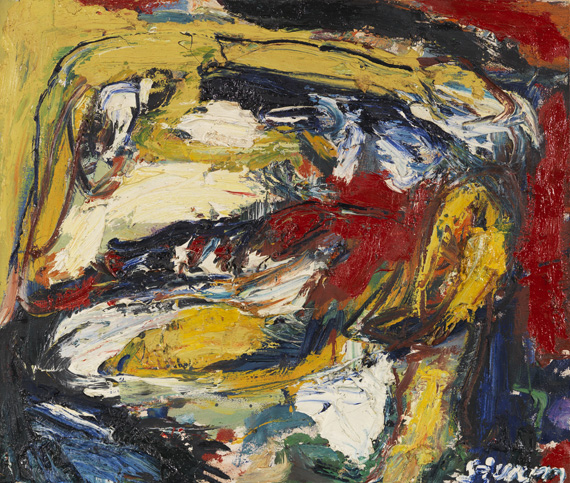Dictionary


SPUR
The SPUR group (German: Track or Trace) was one of the most important artists’ groups in post-war Germany, and played a key role in the development of German Informel art. Founding members included the painters Heimrad Prem (1934-78), Helmut Sturm (1932-2008) and HP (Hans Peter) Zimmer (1936-92), as well as the sculptor Lothar Fischer (1933-2004). The artists were all students at the Akademie der Bildenden Künste in Munich. The group documented its beginnings in the "SPUR-Historie" in their "SPUR-Buch" (SPUR Book), which was published in 1962; "SPUR Group, made in Germany 1957, name found on the Schneematschstraße in January 1958".
In 1958, the group published its first manifesto, which contained 21 theses. It was signed by Heimrad Prem, HP Zimmer, Helmut Sturm, Lothar Fischer Asger Jorn, Erwin Eisch and Gretel Stadler, amongst others. In the manifesto, the group provocatively and ironically announced the coming "cultural putsch" against modern abstract art and the birth of "polydimensional" painting. The manifesto also used the term "Situationism", thus making direct reference to the revolutionary art movement the Situationist International, founded in 1957. The SPUR group joined the Situationist International during its third conference in 1959. In 1960, Dieter Kunzelmann (born 1939) and Uwe Lausen (1941-70) came into contact with the group, and lending it important artistic impulses. SPUR regarded itself as an open platform, offering a forum for diverse artistic styles. Nonetheless, SPUR artists also wanted to establish a common form of artistic expression. Over the course of its existence, the group was influenced by various styles. In 1960, the group embraced the "Facettenstil", the vivid portrayal of suffering characteristic of German Gothic art and the work of Max Beckmann. From 1962, the group’s work displayed increasing figurative tendencies. Although the group undertook these formal experiments, its paintings were always characterised by the vital and gestural style of Informel, the confident use of colour, and a dynamic which seemed to fill up the entire pictorial space and project outwards. The SPUR artists were also influenced by Art Brut and the CoBrA group. SPUR produced various group works, such as the SPUR-Bau and the "Canal Grande Crescente" (both executed in 1963). From 1963, the group published its journal "SPUR", which lasted 7 issues. The occasionally provocative content, which was particularly pronounced in the sixth issue, SPUR IM EXIL, led to a court case being brought against Dieter Kunzelmann, Helmut Sturm, Heimrad Prem and HP Zimmer. The artists were charged with blasphemy and the dissemination of obscene literature. Some years later, the case was suspended. In 1965, the group merged with the Munich artists’ group WIR, and the new union later became known as GEFLECHT (German: network or meshwork).
The SPUR group (German: Track or Trace) was one of the most important artists’ groups in post-war Germany, and played a key role in the development of German Informel art. Founding members included the painters Heimrad Prem (1934-78), Helmut Sturm (1932-2008) and HP (Hans Peter) Zimmer (1936-92), as well as the sculptor Lothar Fischer (1933-2004). The artists were all students at the Akademie der Bildenden Künste in Munich. The group documented its beginnings in the "SPUR-Historie" in their "SPUR-Buch" (SPUR Book), which was published in 1962; "SPUR Group, made in Germany 1957, name found on the Schneematschstraße in January 1958".
In 1958, the group published its first manifesto, which contained 21 theses. It was signed by Heimrad Prem, HP Zimmer, Helmut Sturm, Lothar Fischer Asger Jorn, Erwin Eisch and Gretel Stadler, amongst others. In the manifesto, the group provocatively and ironically announced the coming "cultural putsch" against modern abstract art and the birth of "polydimensional" painting. The manifesto also used the term "Situationism", thus making direct reference to the revolutionary art movement the Situationist International, founded in 1957. The SPUR group joined the Situationist International during its third conference in 1959. In 1960, Dieter Kunzelmann (born 1939) and Uwe Lausen (1941-70) came into contact with the group, and lending it important artistic impulses. SPUR regarded itself as an open platform, offering a forum for diverse artistic styles. Nonetheless, SPUR artists also wanted to establish a common form of artistic expression. Over the course of its existence, the group was influenced by various styles. In 1960, the group embraced the "Facettenstil", the vivid portrayal of suffering characteristic of German Gothic art and the work of Max Beckmann. From 1962, the group’s work displayed increasing figurative tendencies. Although the group undertook these formal experiments, its paintings were always characterised by the vital and gestural style of Informel, the confident use of colour, and a dynamic which seemed to fill up the entire pictorial space and project outwards. The SPUR artists were also influenced by Art Brut and the CoBrA group. SPUR produced various group works, such as the SPUR-Bau and the "Canal Grande Crescente" (both executed in 1963). From 1963, the group published its journal "SPUR", which lasted 7 issues. The occasionally provocative content, which was particularly pronounced in the sixth issue, SPUR IM EXIL, led to a court case being brought against Dieter Kunzelmann, Helmut Sturm, Heimrad Prem and HP Zimmer. The artists were charged with blasphemy and the dissemination of obscene literature. Some years later, the case was suspended. In 1965, the group merged with the Munich artists’ group WIR, and the new union later became known as GEFLECHT (German: network or meshwork).
Offers
Headquarters
Joseph-Wild-Str. 18
81829 Munich
Phone: +49 89 55 244-0
Fax: +49 89 55 244-177
info@kettererkunst.de
Louisa von Saucken / Undine Schleifer
Holstenwall 5
20355 Hamburg
Phone: +49 40 37 49 61-0
Fax: +49 40 37 49 61-66
infohamburg@kettererkunst.de
Dr. Simone Wiechers / Nane Schlage
Fasanenstr. 70
10719 Berlin
Phone: +49 30 88 67 53-63
Fax: +49 30 88 67 56-43
infoberlin@kettererkunst.de
Cordula Lichtenberg
Gertrudenstraße 24-28
50667 Cologne
Phone: +49 221 510 908-15
infokoeln@kettererkunst.de
Hessen
Rhineland-Palatinate
Miriam Heß
Phone: +49 62 21 58 80-038
Fax: +49 62 21 58 80-595
infoheidelberg@kettererkunst.de
We will inform you in time.




